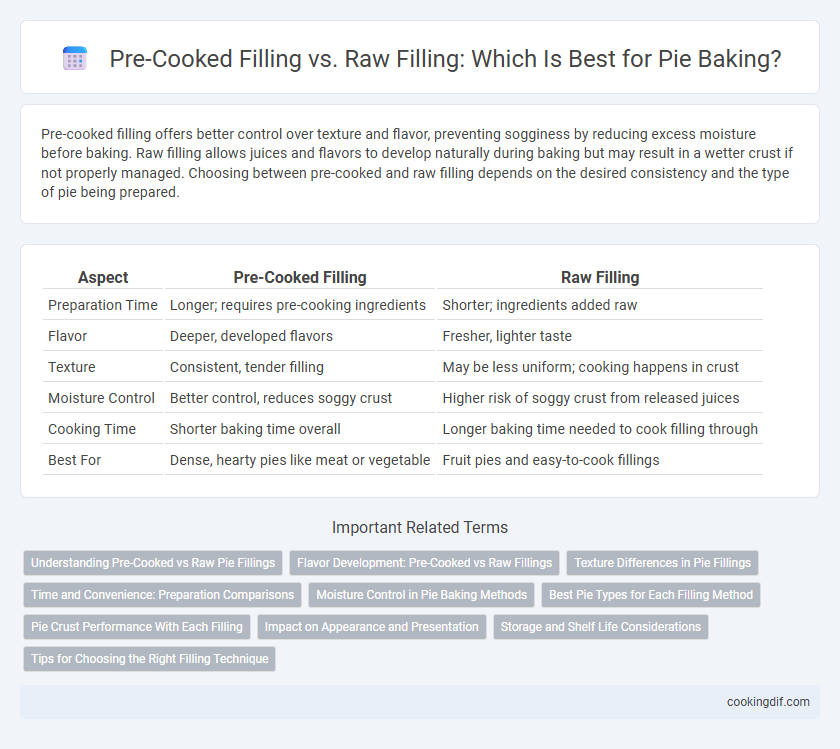Pre-cooked filling offers better control over texture and flavor, preventing sogginess by reducing excess moisture before baking. Raw filling allows juices and flavors to develop naturally during baking but may result in a wetter crust if not properly managed. Choosing between pre-cooked and raw filling depends on the desired consistency and the type of pie being prepared.
Table of Comparison
| Aspect | Pre-Cooked Filling | Raw Filling |
|---|---|---|
| Preparation Time | Longer; requires pre-cooking ingredients | Shorter; ingredients added raw |
| Flavor | Deeper, developed flavors | Fresher, lighter taste |
| Texture | Consistent, tender filling | May be less uniform; cooking happens in crust |
| Moisture Control | Better control, reduces soggy crust | Higher risk of soggy crust from released juices |
| Cooking Time | Shorter baking time overall | Longer baking time needed to cook filling through |
| Best For | Dense, hearty pies like meat or vegetable | Fruit pies and easy-to-cook fillings |
Understanding Pre-Cooked vs Raw Pie Fillings
Pre-cooked pie fillings offer consistent texture and prevent undercooked centers by softening fruit or ingredients before baking, ideal for custard or fruit pies requiring even heat distribution. Raw fillings rely on the pie's baking time to cook ingredients within the crust, which can result in a juicier and fresher flavor but may risk soggy crusts or uneven cooking if time and temperature are not carefully managed. Choosing between pre-cooked and raw fillings depends on the type of pie, desired texture, and baking conditions to achieve optimal taste and structural integrity.
Flavor Development: Pre-Cooked vs Raw Fillings
Pre-cooked pie fillings allow flavors to meld and intensify before baking, resulting in a richer, more developed taste profile compared to raw fillings. Raw fillings, when baked inside the crust, often retain a fresher, more vibrant fruit flavor but may lack the depth that pre-cooking provides. Choosing between pre-cooked and raw fillings depends on the desired balance between complexity and freshness in the pie's flavor.
Texture Differences in Pie Fillings
Pre-cooked pie fillings offer a smoother, more uniform texture as the ingredients have already softened and melded together during cooking, preventing sogginess in the crust. Raw fillings, on the other hand, retain more distinct textures of individual components like fruit chunks or vegetable pieces, leading to a varied and fresh bite after baking. The choice between pre-cooked and raw fillings significantly impacts the pie's overall mouthfeel, balancing between softness and textural contrast.
Time and Convenience: Preparation Comparisons
Pre-cooked pie fillings significantly reduce baking time and offer greater convenience by eliminating the need for extended oven cooking, allowing for quicker meal assembly and serving. Raw fillings, while providing a fresher flavor, require longer baking times to ensure the ingredients are fully cooked and the crust properly browned. Choosing pre-cooked fillings streamlines preparation, making it ideal for busy schedules or last-minute baking.
Moisture Control in Pie Baking Methods
Pre-cooked filling allows for better moisture control by reducing excess liquid that can make the pie crust soggy during baking. Raw filling often releases more moisture as the filling cooks inside the pie, risking a soggy bottom crust and uneven texture. Controlling moisture with pre-cooked fillings results in a crispier crust and a more stable, evenly baked pie.
Best Pie Types for Each Filling Method
Pre-cooked filling is ideal for fruit pies like apple, cherry, and blueberry, as it prevents soggy crusts and ensures even cooking by reducing excess moisture. Raw filling works best for pies such as pumpkin, custard, and pecan, where slow baking allows the filling to set firmly and develop rich flavors. Choosing the proper filling method enhances texture and taste, making each pie type shine with optimal consistency.
Pie Crust Performance With Each Filling
Pre-cooked filling enhances pie crust performance by reducing moisture release during baking, preventing sogginess and ensuring a crisp, flaky texture. Raw filling, when properly thickened, allows flavors to meld within the pie but risks a wetter crust due to moisture released as the filling cooks. Selecting pre-cooked filling is ideal for maintaining structural integrity of the crust, while raw filling requires careful moisture control to avoid compromising crust quality.
Impact on Appearance and Presentation
Pre-cooked pie fillings generally maintain a uniform texture and vibrant color, enhancing the pie's appearance with less shrinkage and bubbling during baking. Raw fillings may release excess moisture, resulting in a soggy crust and uneven surface browning, which can detract from the pie's presentation. Choosing pre-cooked fillings ensures a visually appealing, well-structured pie with a glossy, appetizing finish.
Storage and Shelf Life Considerations
Pre-cooked pie fillings offer extended shelf life due to reduced moisture content and the elimination of raw ingredients that may spoil quickly, making them ideal for longer storage. Raw fillings require refrigeration and have a shorter shelf life because enzymes and bacteria remain active, increasing the risk of spoilage. Proper storage of pre-cooked fillings often involves freezing or airtight containers, while raw fillings must be kept chilled to maintain freshness and prevent microbial growth.
Tips for Choosing the Right Filling Technique
Pre-cooked filling ensures even cooking and prevents soggy crusts by reducing moisture during baking, ideal for fruit fillings like apples or berries. Raw filling works well for recipes with quick-cooking ingredients such as custards or soft fruits, preserving freshness and texture. Choosing the right filling method depends on the moisture content, cooking time, and the desired consistency of the final pie.
Pre-cooked filling vs raw filling for pie baking method Infographic

 cookingdif.com
cookingdif.com